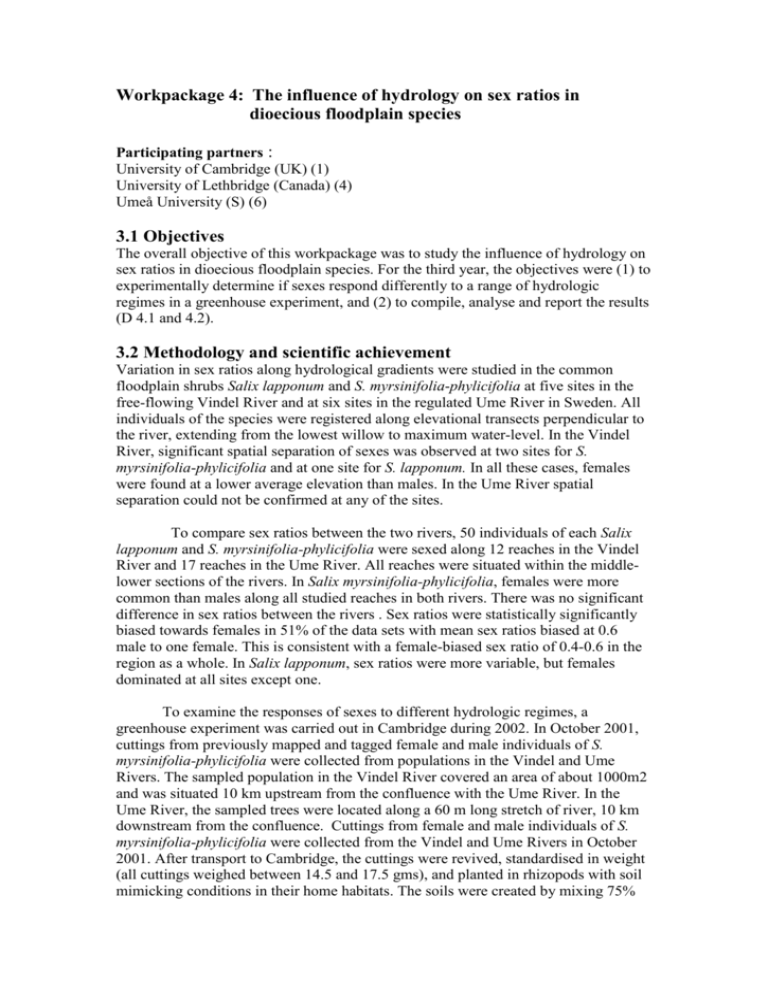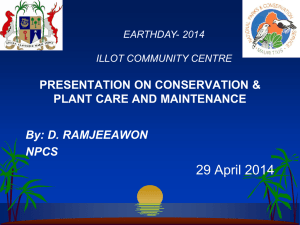
Workpackage 4: The influence of hydrology on sex ratios in
dioecious floodplain species
Participating partners :
University of Cambridge (UK) (1)
University of Lethbridge (Canada) (4)
Umeå University (S) (6)
3.1 Objectives
The overall objective of this workpackage was to study the influence of hydrology on
sex ratios in dioecious floodplain species. For the third year, the objectives were (1) to
experimentally determine if sexes respond differently to a range of hydrologic
regimes in a greenhouse experiment, and (2) to compile, analyse and report the results
(D 4.1 and 4.2).
3.2 Methodology and scientific achievement
Variation in sex ratios along hydrological gradients were studied in the common
floodplain shrubs Salix lapponum and S. myrsinifolia-phylicifolia at five sites in the
free-flowing Vindel River and at six sites in the regulated Ume River in Sweden. All
individuals of the species were registered along elevational transects perpendicular to
the river, extending from the lowest willow to maximum water-level. In the Vindel
River, significant spatial separation of sexes was observed at two sites for S.
myrsinifolia-phylicifolia and at one site for S. lapponum. In all these cases, females
were found at a lower average elevation than males. In the Ume River spatial
separation could not be confirmed at any of the sites.
To compare sex ratios between the two rivers, 50 individuals of each Salix
lapponum and S. myrsinifolia-phylicifolia were sexed along 12 reaches in the Vindel
River and 17 reaches in the Ume River. All reaches were situated within the middlelower sections of the rivers. In Salix myrsinifolia-phylicifolia, females were more
common than males along all studied reaches in both rivers. There was no significant
difference in sex ratios between the rivers . Sex ratios were statistically significantly
biased towards females in 51% of the data sets with mean sex ratios biased at 0.6
male to one female. This is consistent with a female-biased sex ratio of 0.4-0.6 in the
region as a whole. In Salix lapponum, sex ratios were more variable, but females
dominated at all sites except one.
To examine the responses of sexes to different hydrologic regimes, a
greenhouse experiment was carried out in Cambridge during 2002. In October 2001,
cuttings from previously mapped and tagged female and male individuals of S.
myrsinifolia-phylicifolia were collected from populations in the Vindel and Ume
Rivers. The sampled population in the Vindel River covered an area of about 1000m2
and was situated 10 km upstream from the confluence with the Ume River. In the
Ume River, the sampled trees were located along a 60 m long stretch of river, 10 km
downstream from the confluence. Cuttings from female and male individuals of S.
myrsinifolia-phylicifolia were collected from the Vindel and Ume Rivers in October
2001. After transport to Cambridge, the cuttings were revived, standardised in weight
(all cuttings weighed between 14.5 and 17.5 gms), and planted in rhizopods with soil
mimicking conditions in their home habitats. The soils were created by mixing 75%
gravel with 25% peat and loamy soil (this 25% consisting of 3 parts peat and 1 part
loam).
8 rhizopods were used to create 4 experimental treatments (2 rhizopods per
treatment). Each Rhizopod had 8 male and 7/8 female cuttings, each in separate
growth tubes. No two cuttings from the same parent tree were used in any rhizopod
but a similar range of cutting provenances were present in all rhizopod pairs. The two
rhizopods receiving the same treatment were considered to be replicates of each other.
A total of 19 source trees provided cuttings for the experiment, 10 of which were male
and 9 female.
All cuttings received an initial two-week period with optimal growth
conditions during which water tables were held a few centimetres below the soil
surface to give good soil moisture and good soil aeration. Subsequently, the rhizopods
were subjected to hydrological regimes that were chosen to represent ranges of waterlevel variation and precipitation in the Vindel and Ume Rivers (Table 1). The
experiment ran from January 28thth until May 7th, 2002. During the experiment, the
following environmental measurements were made: Soil suction/pressure using
tensiometers connected to Campbell data loggers; soil, water and air temperatures
using thermocouples and Photosynthetically Active Radiation (PAR). Shoot length
measurements were made at two- week intervals during the experiment. After
harvesting in May, measurements of shoot dry weight, root length and root dry
weight divided into 10cm sections (measured downwards from the base of the
cutting) were made. In addition, stable isotopes of oxygen (18O) in leaf water and
carbon (13C) in dry leaf matter were used to evaluate water use and photosynthetic
characteristics over the course of the experiment. Measurements were made from
harvested leaf samples at fortnightly intervals on one female clone and one male clone
across the 4 water table treatments. At the end of the experiment, soil samples were
collected from two depths in one growth tube in each rhizopod and analysed for pH,
EC, % water, % organic matter, % Ca CO3 and particle size.
The data were analysed in a full factorial univariate analysis of variance with
root and shoot weights at harvest as response variables and hydrologic regime,
population origin and sex as predictors. Cutting diameter was included as a covariate.
Growth of the willow cuttings were to various degrees determined by all examined.
The hydrologic regime had a significant effect on both shoot and root growth. The
fluctuating water regime (regime 2) produced significantly higher root and shoot
growth than the other three regimes with shoot weights approximately twice as great
in regime 2 as in the other three regimes. The population origin also had a significant
effect on growth over the course of the experiment. Both shoot and root weights were
significantly higher in plants grown from cuttings with source trees in the freeflowing Vindel River than those from the regulated Ume River. The difference
between growth of male and female cuttings across the experiment was significant for
shoot weight but not for root weight.
3.3 Socio-economic relevance and policy implication
During the last century, most larger rivers in northern Sweden have been regulated for
hydropower production. This has led to large changes in water-level regimes, in
riparian habitats, and in the structure and composition of the riparian vegetation. If
willows display a habitat-related spatial variation in sex ratios on floodplains, it is
possible that changes in sex ratios have occurred in regulated rivers with potentially
serious consequences for reproductive and dispersal processes.
3.4 Discussion and conclusion
Numerous studies have shown ecological, morphological, and physiological
differences between genders in dioecious plant species. This is usually interpreted as a
consequence of different resource demands for male and female reproduction. As a
result, the sexes often display different degrees of spatial separation. Along rivers in
northern Sweden, species of the dioecious genus Salix dominate the riparian tree- and
shrub vegetation. It is not known if and to what degree these species display spatial
separation of sexes and how drastic changes in hydrology will influence the spatial
distribution of sexes, reproductive and dispersal processes. The field observations on
Salix lapponum and S. myrsinifolia-phylicifolia were not unambiguous. Spatial
separation of the sexes, with females dominating at the wetter end of the hydrologic
gradient, were observed at some sites in the free-flowing Vindel River but not at all
in the Ume River. This may possibly indicate that a regulated and short-term
fluctuating hydrologic regime in the Ume River prevents spatial separation. There is,
however, nothing in our results to indicate that sex ratios on a reach scale would be
affected by a regulated hydrologic regime.
Data from the greenhouse experiment show a number of interesting trends.
The higher growth exhibited by plants grown from cuttings with source trees in the
free-flowing Vindel River compared with growth of cuttings from the Ume River
suggests that these Vindel cuttings were perhaps healthier or more vigorous at the
outset. Further analysis of data on cutting health collected prior to and during the
experiment and choice of cuttings for the experiment is required for full interpretation
(cuttings were chosen so that even numbers of healthy male and female cuttings were
located in each rhizopod and ignored river origin).
The higher growth exhibited by cuttings grown in a fluctuating water table
regime, regardless of sex and river origin, suggests that good access to water
combined with good oxygenation are preferred conditions for cutting growth.
However, considerable further analysis of growth data are required. In particular
analyses of total root length and root distribution through the sediment profile, by
hydrologic regime are required. It is anticipated that root length/root weight ratios will
add interesting additional information on growth under different hydrologic regimes.
These growth data also need to be analysed in the light of results of soils analyses
performed at the end of the experiment.
Data from the studies of water use during the experiment using stable isotopes
of oxygen (18O) in leaf water and carbon (13C) in dry leaf matter have not yet been
fully interpreted.
3.5 Plan and objectives for the next period
The draft academic paper on the influence of environmental variation on sex ratios in
dioecious floodplain trees will be finalised and submitted within a year.







